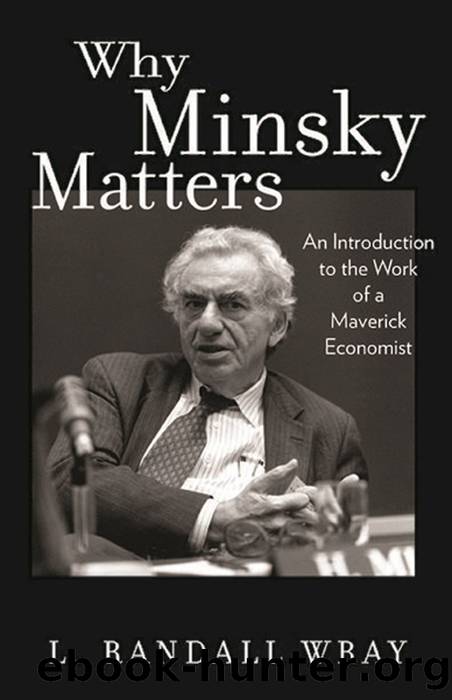Why Minsky Matters by Wray L. Randall

Author:Wray, L. Randall
Language: eng
Format: epub, pdf
Publisher: Princeton University Press
Published: 2015-06-15T00:00:00+00:00
6
â
Minsky and the Global Financial Crisis
At the annual banking structure and competition conference of the Federal Reserve Bank of Chicago in May 1987, the buzzword heard in the corridors and used by many of the speakers was âthat which can be securitized, will be securitized.â
âMinsky, 19871
There is a symbiotic relation between the globalization of the worldâs financial structure and the securitization of financial instruments. Globalization requires the conformity of institutions across national lines and in particular the ability of creditors to capture assets that underlie the securities.
âMinsky, 19872
Securitization reflects a change in the weight of market and bank funding capabilities: market funding capabilities have increased relative to the funding abilities of banks and depository financial intermediaries. It is in part a lagged response to monetarism. The fighting of inflation by constraining monetary growth opened opportunities for nonbanking financing techniques.
âMinsky, 19873
The emergence of money manager capitalism means that the financing of the capital development of the economy has taken a back seat to the quest for short run total returns.
âMinsky, 1992, p. 324
When the GFC (Global Financial Crisis) struck, many commentators called it the âMinsky crisisâ or âMinsky moment,â recognizing the work of Minsky whoâas discussed earlierâhad developed the âfinancial instability hypothesisâ that described the transformation of an economy from a ârobustâ financial structure to a âfragileâ one. A ârun of good timesâ would encourage ever-greater risk-taking, and growing instability would be encouraged if financial crises were resolved by swift government intervention.
As Minsky insisted âstability is destabilizingâ5âand this seemed to perfectly describe the last few decades of U.S. experience, during which financial crises became more frequent and increasingly severe. We could list, for example, the savings and loan crisis of the 1980s, the stock market crash of 1987, the developing country debt crises (1980s to early 1990s), the Long Term Capital Markets (1998) and Enron (2001) fiascoes, and the dot-com collapse (2000â2001) as precursors to the final âgreat crashâ in 2007.6
Each of these crises led to U.S. government intervention that prevented a downward spiral of financial markets or of the economy (although in some cases, recessions followed the crises); indeed, after the dot-com crisis, the belief was that a new Great Moderation7 had taken hold in the United States, making serious downturns impossible. This notion encouraged more risk, more financial layering, and more leveraging (debt issued against debt, with little net worth backing it up). All of this dangerous financial structure fits Minskyâs arguments about growing financial instability.
So, though it is completely appropriate to give credit to Minskyâs foresight, we also need to look at Minskyâs later writings, which developed a âstagesâ approach to the longer term transformation of the financial system. This approach went well beyond the âfinancial theory of investment and investment theory of the cycleâ that Minsky had begun to develop in the 1950s.
Download
This site does not store any files on its server. We only index and link to content provided by other sites. Please contact the content providers to delete copyright contents if any and email us, we'll remove relevant links or contents immediately.
International Integration of the Brazilian Economy by Elias C. Grivoyannis(91522)
The Radium Girls by Kate Moore(11927)
Turbulence by E. J. Noyes(7941)
Nudge - Improving Decisions about Health, Wealth, and Happiness by Thaler Sunstein(7622)
The Black Swan by Nassim Nicholas Taleb(7016)
Rich Dad Poor Dad by Robert T. Kiyosaki(6413)
Pioneering Portfolio Management by David F. Swensen(6229)
Man-made Catastrophes and Risk Information Concealment by Dmitry Chernov & Didier Sornette(5924)
Zero to One by Peter Thiel(5690)
Secrecy World by Jake Bernstein(4651)
Millionaire: The Philanderer, Gambler, and Duelist Who Invented Modern Finance by Janet Gleeson(4382)
The Age of Surveillance Capitalism by Shoshana Zuboff(4214)
Skin in the Game by Nassim Nicholas Taleb(4165)
Bullshit Jobs by David Graeber(4100)
The Money Culture by Michael Lewis(4082)
Skin in the Game: Hidden Asymmetries in Daily Life by Nassim Nicholas Taleb(3935)
The Dhandho Investor by Mohnish Pabrai(3705)
The Wisdom of Finance by Mihir Desai(3658)
Blockchain Basics by Daniel Drescher(3511)
